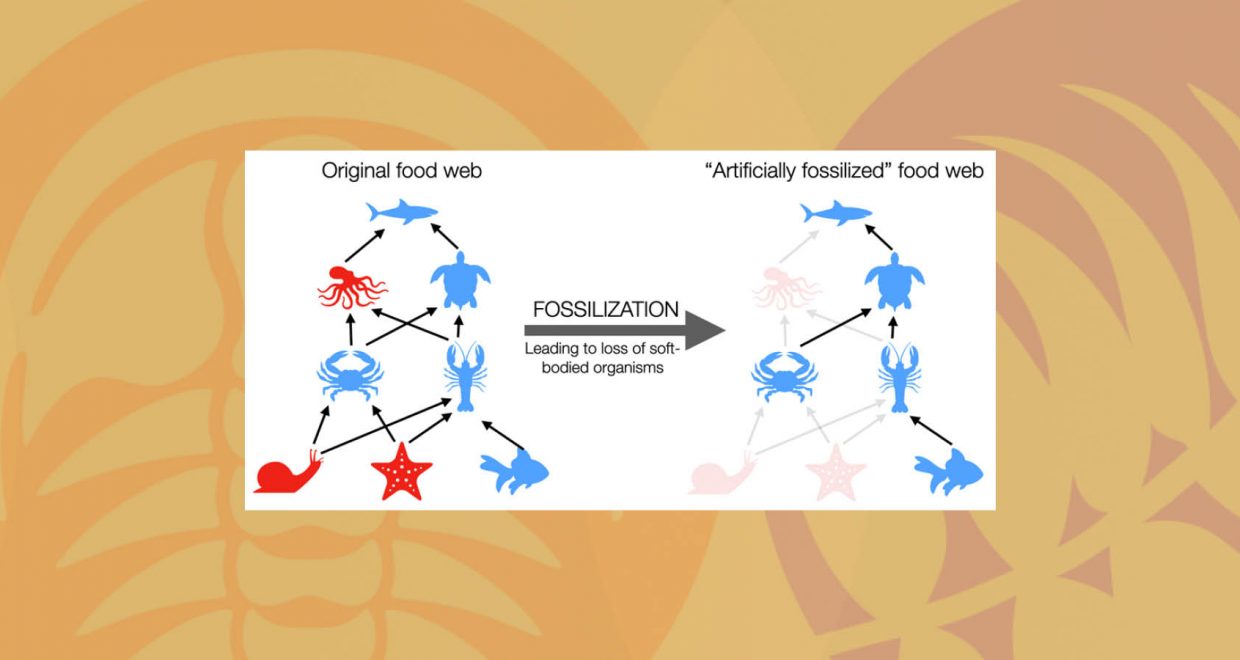The importance of soft-bodied organisms in ancient food webs
Past extinction events are key to understanding how modern life will respond to climate change. For ecologists who study communities of interacting organisms, the fossil record holds a wealth of information about how different species react to environmental perturbations, but with a major drawback — it only captures species with bones and shells.
In a recent paper, my colleagues and I identified how one key bias in the fossil record—the lack of preservation of soft-bodied organisms, such as worms—might impact how we understand ancient communities and their dynamics.
Our research builds on the burgeoning science of food webs, which are networks of different organisms represented as “nodes” connected by “edges” that represent consumer-resource interactions. Mathematical analyses of food webs have revealed various aspects of community dynamics, such as stability, and are also used to evaluate how ecological communities may respond to future perturbations, such as abrupt climate change. Studies like this are becoming increasingly important considering our rapidly changing climate. However, inferences from modern food webs are limited by the fact that existing ecosystems have not experienced the range or intensity of climatic and other perturbations forecast for the future (i.e., modern food webs cannot adequately serve as analogs for the future).
The limitations of modern food webs have led researchers to turn to the fossil record to enhance our understanding of community responses to the significant current and future perturbations. The fossil record documents many different disturbances across the history of animal life. For example, researchers analyzing food webs constructed from fossil data have assessed community responses to perturbations such as mass extinctions (e.g., Roopnarine and Angielczyk 2015), which can help scientists to understand how the ongoing “sixth extinction” will affect the trajectory of modern life.
Unfortunately, fossil data is biased. Unlike modern data, fossilized records of ancient communities are subjected to information loss caused by geological processes that can destroy evidence of the existence of certain taxa. This will affect how researchers interpret biotic interactions and ecosystem properties recorded in ancient food webs. Such biases need to be accounted for to draw robust ecological inferences about the past and future.
To do so, we analyzed whether soft- and hard-bodied organisms play different roles in their communities. If they do, then the loss of soft-bodied organisms from the fossil record will lead to communities that appear to lack the roles that soft-bodied organisms play. By “artificially fossilizing” (i.e., removing organisms that likely would not survive fossilization) a series of modern food webs, we looked at how preservation biases affected the quantitative structure of “fossilized” food webs.
We found that selective loss of soft-bodied organisms had predictable effects on the community structure of artificially fossilized food webs because these organisms occupy unique, consistent food web positions. We also found that these ecological differences between soft- and hard-bodied taxa are present in fossilized food webs from the early Eocene, but not from the Cambrian. This suggests that ecological differences between these two groups have existed for at least 48 million years. As a result of these longstanding unique ecological positions for soft-bodied taxa, we found that the loss of evidence for soft-bodied organisms during fossilization makes ancient food webs appear less stable, with less predation and an overrepresentation of generalist consumers that eat a wider variety of resources. Our results indicate that accounting for soft-bodied taxa is vital for accurate depictions of ancient food webs. Fortunately, the consistency of information loss trends across the analyzed food webs in our study suggests that it is possible to predict how the selective loss of soft-bodied taxa affects food web metrics. By correcting for the loss of soft-bodied taxa from ancient food webs, we can better model and study ancient communities.

The authors would like to thank Jenna Marshall for editing this blog post.
“Disentangling ecological and taphonomic signals in ancient food webs”, by Jack O. Shaw, Emily Coco, Kate Wootton, Dries Daems, Andrew Gillreath-Brown, Anshuman Swain and Jennifer A. Dunne has been published Open Access in Paleobiology, published by Cambridge University Press on behalf of the Paleontological Society.
Read other blog posts from Paleobiology here.
or view all blog posts from the Paleontological Society Journals






